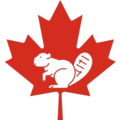Portal:Canada
| Showcase | Contents | Contributing |
Introduction
Canada is a country in North America. Its ten provinces and three territories extend from the Atlantic Ocean to the Pacific Ocean and northward into the Arctic Ocean, making it the world's second-largest country by total area, with the world's longest coastline. Its border with the United States is the world's longest international land border. The country is characterized by a wide range of both meteorologic and geological regions. With a population of just over 41 million people, it has widely varying population densities, with the majority residing in urban areas and large areas of the country being sparsely populated. Canada's capital is Ottawa and its three largest metropolitan areas are Toronto, Montreal, and Vancouver.
A developed country, Canada has a high nominal per capita income globally and its advanced economy ranks among the largest in the world by nominal GDP, relying chiefly upon its abundant natural resources and well-developed international trade networks. Recognized as a middle power, Canada's support for multilateralism and internationalism has been closely related to its foreign relations policies of peacekeeping and aid for developing countries. Canada promotes its domestically shared values through participation in multiple international organizations and forums. (Full article...)
Featured article -
Queen Anne's War (1702–1713) or the Third Indian War was the second in a series of French and Indian Wars fought in North America involving the colonial empires of Great Britain, France, and Spain; it took place during the reign of Anne, Queen of Great Britain. In the United States, it is often studied as a standalone conflict under this name, although it is also viewed as the American theater of the War of the Spanish Succession. In France, it was known as the Second Intercolonial War. (Full article...)
Current events
- April 21, 2025 –
- ARK Invest becomes the first US-based asset manager to gain exposure to the Solana blockchain through an ETF investment after Canada approves several spot Solana ETFs. (Coin Market Cap)
- April 16, 2025 – Tariffs in the second Trump administration
- California Governor Gavin Newsom and California Attorney General Rob Bonta file a lawsuit against U.S. President Donald Trump and his administration over the tariffs, making California the first U.S. state to do so. The lawsuit also targets the International Economic Emergency Powers Act, the law used by Trump to impose tariffs against Canada, China, and Mexico. (Politico)
- April 15, 2025 –
- Four people are injured in a vehicle-ramming attack after a person drives a sedan onto a pedestrian walkway on the Toronto Metropolitan University campus near Yonge Street and Gerrard Street in Toronto, Ontario, Canada. (CBC News)
- April 9, 2025 – Tariffs in the second Trump administration, Executive orders in the second presidency of Donald Trump
- Canada announces a 25% tariff on certain vehicle imports from the U.S. as retaliation against a previous similar measure from the U.S. (BBC News)
- April 3, 2025 – Tariffs in the second Trump administration
- Multinational car manufacturer Stellantis announces it will lay off 900 workers across five of its U.S. factories and will pause production at assembly plants in Canada and Mexico in response to the tariffs. (Reuters)
- April 3, 2025 – Canada convoy protests
- The Ontario Court of Justice in Ontario, Canada, convicts Tamara Lich and Chris Barber, two leaders of the truck driver protest movement against COVID-19 vaccination in Canada, of criminal mischief. (AP)
Selected panorama -
National symbol -

The National Flag of Canada (French: Drapeau national du Canada), often referred to simply as the Canadian flag, consists of a red field with a white square at its centre in the ratio of 1∶2∶1, in which is featured one stylized, red, 11-pointed maple leaf charged in the centre. It is the first flag to have been adopted by both houses of Parliament and officially proclaimed by the Canadian monarch as the country's official national flag. The flag has become the predominant and most recognizable national symbol of Canada. (Full article...)
Selected vital article -
The culture of Canada embodies the artistic, culinary, literary, humour, musical, political and social elements that are representative of Canadians. Throughout Canada's history, its culture has been influenced firstly by its indigenous cultures, and later by European culture and traditions, mostly by the British and French. Over time, elements of the cultures of Canada's immigrant populations have become incorporated to form a Canadian cultural mosaic. Certain segments of Canada's population have, to varying extents, also been influenced by American culture due to shared language (in English-speaking Canada), significant media penetration, and geographic proximity. (Full article...)
Selected picture -
Featured biography -
Elizabeth II (Elizabeth Alexandra Mary; 21 April 1926 – 8 September 2022) was Queen of the United Kingdom and other Commonwealth realms from 6 February 1952 until her death in 2022. She had been queen regnant of 32 sovereign states during her lifetime and was the monarch of 15 realms at her death. Her reign of 70 years and 214 days is the longest of any British monarch, the second-longest of any sovereign state, and the longest of any queen regnant in history. (Full article...)
Did you know -

- ... that a member of the House of Lords was the principal of a Canadian junior school?
- ... that Canadian artist Tom Forrestall spent six months painting his own car?
- ... that Canadian surgeon Robin McLeod advocated for post-operative patients to get back on their feet and move around immediately, against the prevailing guidance that they should stay in bed?
- ... that John Hutchison, in his role as Mayor of Toronto, signed the city's bid to become the capital of the Province of Canada?
- ... that Carrie Jenkins Harris, the North American writer who died in 1903, should not be confused with Carrie Jenkins Harris, the North American writer and editor who died in 1903?
- ... that jazz singer Judi Singh's mother and father were, respectively, among the earliest Black and Sikh settlers of Alberta, Canada?
- ... that Canadian professional ice hockey player Larry Jeffrey had eleven knee surgeries in a span of nine years?
Featured list -
The 400-series highways are a network of controlled-access highways in the Canadian province of Ontario, forming a special subset of the provincial highway system. They are analogous to the Interstate Highway System in the United States or the Autoroute system of neighbouring Quebec, and are regulated by the Ministry of Transportation of Ontario (MTO). The 400-series designations were introduced in 1952, although Ontario had been constructing divided highways for two decades prior. Initially, only Highways 400, 401 and 402 were numbered; other designations followed in the subsequent decades. To this day, not all controlled-access highways in Ontario are a part of the 400-series highway network. The network is situated almost entirely in Southern Ontario, although Highway 400 extends into the more remote northern portion of the province. (Full article...)
Main articles
Associated Wikimedia
The following Wikimedia Foundation sister projects provide more on this subject:
-
Commons
Free media repository -
Wikibooks
Free textbooks and manuals -
Wikidata
Free knowledge base -
Wikinews
Free-content news -
Wikiquote
Collection of quotations -
Wikisource
Free-content library -
Wikiversity
Free learning tools -
Wikivoyage
Free travel guide -
Wiktionary
Dictionary and thesaurus





























